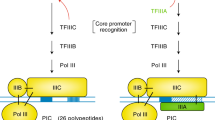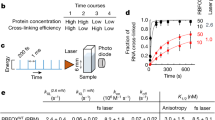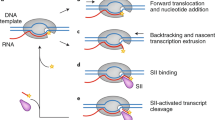Abstract
We have recently shown that a fraction of the total cellular pool of the small GTPase RhoA resides in the nucleus, and that the nuclear guanine nucleotide exchange factor (GEF) Net1 has a role in the regulation of its activity. In this protocol, we describe a method to measure both the activities of the nuclear pools of RhoA and Rho GEFs. This process required the development of a nuclear isolation protocol that is both fast and virtually free of cytosolic and membrane contaminants, as well as a redesign of existing RhoA and Rho GEF activity assays so that they work in nuclear samples. This protocol can be also used for other Rho GTPases and Rho GEFs, which have also been found in the nucleus. Completion of the procedure, including nuclear isolation and RhoA or Rho GEF activity assay, takes 1 h 40 min. We also include details of how to perform a basic assay of whole-cell extracts.
This is a preview of subscription content, access via your institution
Access options
Subscribe to this journal
Receive 12 print issues and online access
$259.00 per year
only $21.58 per issue
Buy this article
- Purchase on Springer Link
- Instant access to full article PDF
Prices may be subject to local taxes which are calculated during checkout



Similar content being viewed by others
References
Van Aelst, L. & D'Souza-Schorey, C. Rho GTPases and signaling networks. Genes Dev. 11, 2295–2322 (1997).
Burridge, K. & Wennerberg, K. Rho and Rac take center stage. Cell 116, 167–179 (2004).
Rossman, K.L., Der, C.J. & Sondek, J. GEF means go: turning on RHO GTPases with guanine nucleotide-exchange factors. Nat. Rev. Mol. Cell Biol. 6, 167–180 (2005).
Bernards, A. GAPs galore! A survey of putative Ras superfamily GTPase activating proteins in man and Drosophila. Biochim. Biophys. Acta. 1603, 47–82 (2003).
Ren, X.D., Kiosses, W.B. & Schwartz, M.A. Regulation of the small GTP-binding protein Rho by cell adhesion and the cytoskeleton. EMBO J. 18, 578–585 (1999).
Benard, V., Bohl, B.P. & Bokoch, G.M. Characterization of rac and cdc42 activation in chemoattractant-stimulated human neutrophils using a novel assay for active GTPases. J. Biol. Chem. 274, 13198–13204 (1999).
Ellerbroek, S.M. et al. SGEF, a RhoG guanine nucleotide exchange factor that stimulates macropinocytosis. Mol. Biol. Cell 15, 3309–3319 (2004).
Garcia-Mata, R. et al. Analysis of activated GAPs and GEFs in cell lysates. Methods Enzymol. 406, 425–437 (2006).
Chen, S.Y., Huff, S.Y., Lai, C.C., Der, C.J. & Powers, S. Ras-15A protein shares highly similar dominant-negative biological properties with Ras-17N and forms a stable, guanine-nucleotide resistant complex with CDC25 exchange factor. Oncogene 9, 2691–2698 (1994).
Ridley, A.J. & Hall, A. The small GTP-binding protein rho regulates the assembly of focal adhesions and actin stress fibers in response to growth factors. Cell 70, 389–399 (1992).
Ridley, A.J., Paterson, H.F., Johnston, C.L., Diekmann, D. & Hall, A. The small GTP-binding protein rac regulates growth factor-induced membrane ruffling. Cell 70, 401–410 (1992).
Garrett, M.D., Self, A.J., van Oers, C. & Hall, A. Identification of distinct cytoplasmic targets for ras/R-ras and rho regulatory proteins. J. Biol. Chem. 264, 10–13 (1989).
Barbacid, M. ras genes. Annu. Rev. Biochem. 56, 779–827 (1987).
Trahey, M. & McCormick, F. A cytoplasmic protein stimulates normal N-ras p21 GTPase, but does not affect oncogenic mutants. Science 238, 542–545 (1987).
Feig, L.A. Tools of the trade: use of dominant-inhibitory mutants of Ras-family GTPases. Nat. Cell Biol. 1, E25–E27 (1999).
Cherfils, J. & Chardin, P. GEFs: structural basis for their activation of small GTP-binding proteins. Trends Biochem. Sci. 24, 306–311 (1999).
Dubash, A.D. et al. The small GTPase RhoA localizes to the nucleus and is activated by Net1 and DNA damage signals. PLoS One 6, e17380 (2011).
Michaelson, D. et al. Rac1 accumulates in the nucleus during the G2 phase of the cell cycle and promotes cell division. J. Cell Biol. 181, 485–496 (2008).
Grabocka, E. & Wedegaertner, P.B. Disruption of oligomerization induces nucleocytoplasmic shuttling of leukemia-associated rho Guanine-nucleotide exchange factor. Mol. Pharmacol. 72, 993–1002 (2007).
Yao, Q., Jin, W.L., Wang, Y. & Ju, G. Regulated shuttling of Slit-Robo-GTPase activating proteins between nucleus and cytoplasm during brain development. Cell. Mol. Neurobiol. 28, 205–221 (2008).
Dingova, H., Fukalova, J., Maninova, M., Philimonenko, V.V. & Hozak, P. Ultrastructural localization of actin and actin-binding proteins in the nucleus. Histochem. Cell Biol. 131, 425–434 (2009).
Scholz, R.-P. et al. DLC1 interacts with 14-3-3 proteins to inhibit RhoGAP activity and block nucleocytoplasmic shuttling. J. Cell Sci. 122, 92–102 (2009).
Graham, J., Ford, T. & Rickwood, D. The preparation of subcellular organelles from mouse liver in self-generated gradients of iodixanol. Anal. Biochem. 220, 367–373 (1994).
Graham, J.M. The isolation of nuclei and nuclear membranes from rat liver. Methods Mol. Biol. 19, 19–28 (1993).
Graham, J.M. Isolation of nuclei and nuclear membranes from animal tissues. Curr. Protoc. Cell Biol. Chapter 3. Unit 3. 10 (2001).
Reuther, G.W. et al. Leukemia-associated Rho guanine nucleotide exchange factor, a Dbl family protein found mutated in leukemia, causes transformation by activation of RhoA. J. Biol. Chem. 276, 27145–27151 (2001).
Danowski, B.A. Fibroblast contractility and actin organization are stimulated by microtubule inhibitors. J. Cell Sci. 93 (Pt 2): 255–266 (1989).
Krendel, M., Zenke, F.T. & Bokoch, G.M. Nucleotide exchange factor GEF-H1 mediates cross-talk between microtubules and the actin cytoskeleton. Nat. Cell Biol. 4, 294–301 (2002).
Vouret-Craviari, V., Bourcier, C., Boulter, E. & van Obberghen-Schilling, E. Distinct signals via Rho GTPases and Src drive shape changes by thrombin and sphingosine-1-phosphate in endothelial cells. J. Cell Sci. 115, 2475–2484 (2002).
Guerra, L. et al. A bacterial cytotoxin identifies the RhoA exchange factor Net1 as a key effector in the response to DNA damage. PLoS One 3, e2254 (2008).
Schmidt, A. & Hall, A. The Rho exchange factor Net1 is regulated by nuclear sequestration. J. Biol. Chem. 277, 14581–14588 (2002).
Dubash, A.D. et al. A novel role for Lsc/p115 RhoGEF and LARG in regulating RhoA activity downstream of adhesion to fibronectin. J. Cell Sci. 120, 3989–3998 (2007).
Garcia-Mata, R. et al. The nuclear RhoA-exchange factor Net1 interacts with proteins of the Dlg family, affects their localization and influences their tumor suppressor activity. Mol. Cell Biol. 27, 8683–8697 (2007).
Acknowledgements
This work was supported by a Department of Defense Breast Cancer Predoctoral Fellowship (BC051092) to A.D.D., an American Heart Association Beginning Grant-in-Aid to R.G.-M. and a Marie Curie Outgoing International Fellowship from the European Union Seventh Framework Programme (FP7/2007-2013) under grant agreement no. 254747 to C.G. We thank K. Burridge for his continuous support, H. Mekeel for his assistance with electron microscopy and L. Sharek for her technical assistance.
AUTHOR CONTRIBUTIONS
R.G.-M. conceived and supervised the project, and devised and optimized the nuclear isolation strategy. R.G.-M., A.D.D. and C.G. devised and optimized the nuclear RhoA and Rho GEF activity pull-downs. R.G.-M. wrote the manuscript.
Author information
Authors and Affiliations
Corresponding author
Ethics declarations
Competing interests
The authors declare no competing financial interests.
Rights and permissions
About this article
Cite this article
Guilluy, C., Dubash, A. & García-Mata, R. Analysis of RhoA and Rho GEF activity in whole cells and the cell nucleus. Nat Protoc 6, 2050–2060 (2011). https://doi.org/10.1038/nprot.2011.411
Published:
Issue Date:
DOI: https://doi.org/10.1038/nprot.2011.411
This article is cited by
-
Enhanced BCAT1 activity and BCAA metabolism promotes RhoC activity in cancer progression
Nature Metabolism (2023)
-
The RhoA dependent anti-metastatic function of RKIP in breast cancer
Scientific Reports (2021)
-
Replicative senescence in MSCWJ-1 human umbilical cord mesenchymal stem cells is marked by characteristic changes in motility, cytoskeletal organization, and RhoA localization
Molecular Biology Reports (2020)
-
Distinctive requirement of PKCε in the control of Rho GTPases in epithelial and mesenchymally transformed lung cancer cells
Oncogene (2019)
-
Exosomes from metastatic cancer cells transfer amoeboid phenotype to non-metastatic cells and increase endothelial permeability: their emerging role in tumor heterogeneity
Scientific Reports (2017)
Comments
By submitting a comment you agree to abide by our Terms and Community Guidelines. If you find something abusive or that does not comply with our terms or guidelines please flag it as inappropriate.



